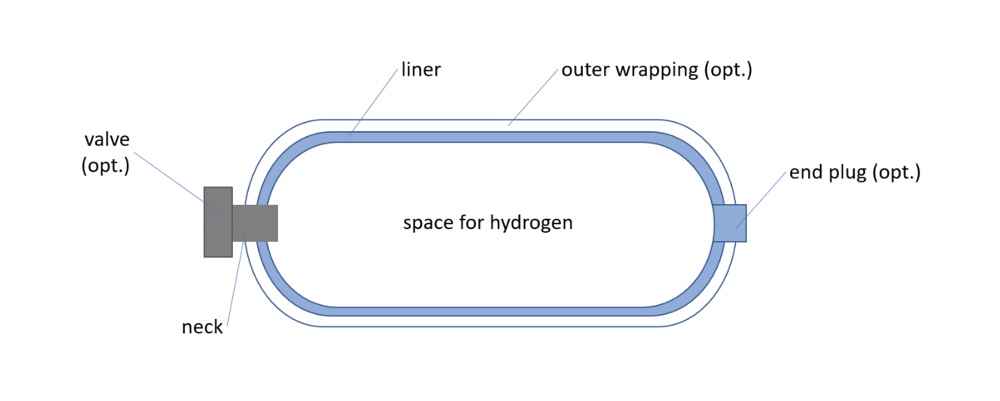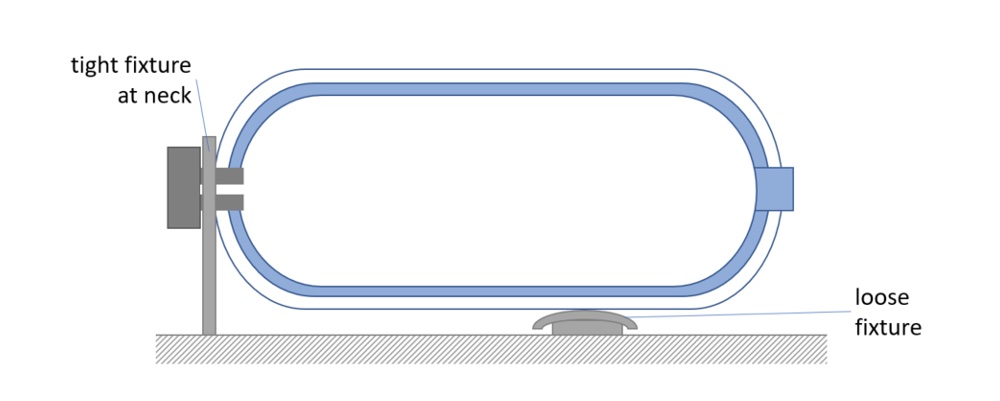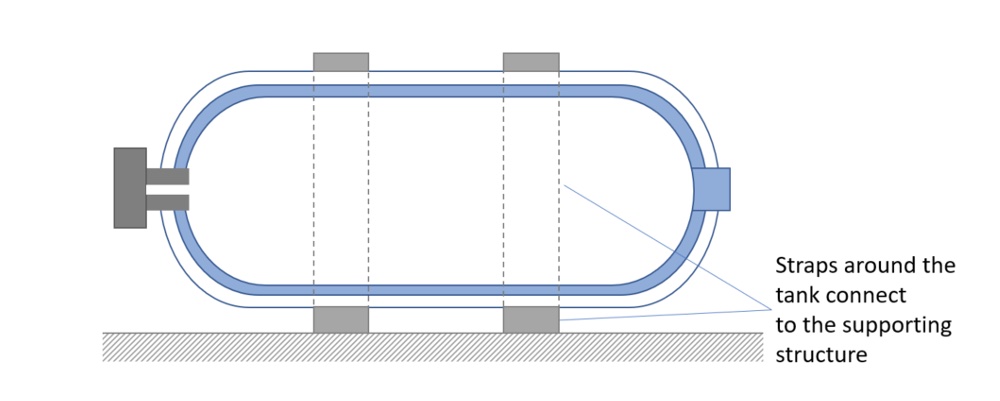- What is a hydrogen tank?
- What are requirements and key performance criteria of hydrogen gas tanks?
- Which are the typical metrics used when selecting hydrogen fuel tanks?
- What are the components hydrogen storage tanks?
- What is the difference between a neck mount and a strap mount?
- What are the different types of hydrogen tanks/hydrogen cylinders?
- What are the interfaces of a hydrogen tank?
- Which hydrogen cylinder is best for my product or application?
- What are special considerations for liquid hydrogen tanks (LH2 tanks)?
- What are the safety and certification requirements to H2 tanks?
- What are the main suppliers of hydrogen tanks?
Browse hydrogen tanks from leading suppliers on our marketplace!
What is a hydrogen tank?
A hydrogen tank is a container or a vessel used to store hydrogen in its gaseous or liquid form. Sometimes they are also referred to as hydrogen cylinders, cartridges or canisters. Depending on the pressure and temperature of storage the container must fulfil various tedious physical requirements, and therefore the art and science of designing and manufacturing hydrogen tanks has a long history of innovation. Hydrogen fuel tanks are used in all kinds of applications involving the use or generation of hydrogen such as fuel cell and electrolyzer systems, rockets and space flight. A hydrogen fuel tank is usually part of a hydrogen storage system.
What are requirements and key performance criteria of hydrogen gas tanks?
Hydrogen is a non-toxic, colorless, odorless, tasteless and highly combustible energy carrier which is also extremely light and can diffuse through certain materials. These characteristics associate it with a certain level of risk in storage. The following are key requirements to hydrogen tanks:
- Leak tightness – it is a primary requirement to any hydrogen tank that it safely retains all the hydrogen stored in it and only releases it under controlled safe conditions.
- Compact construction, so that the storage vessel does not take up much more additional space in comparison to the stored hydrogen.
- High fatigue resistance – the tank can be expected to be filled, emptied and refilled many times. Running through this sequence is referred to as cycling. Generally the more cycles a tank can withstand the longer it can be expected to last. In addition hydrogen can embrittle certain metallic materials causing them to become physically weak and this needs to be equally considered in the design of hydrogen tanks.
- Adequate weight – Though low weight this is not a requirement in all applications weight is important. Tanks form a considerable part of any application using the hydrogen and therefore can have a considerable weight effect on the entire system.
Which are the typical metrics used when selecting hydrogen fuel tanks?
- Tank inner volume in liters
- Operating storage pressure in bar or pascal
- Mass of hydrogen stored at the operating storage pressure in kg
- Operating temperature range in °C
- Maximum allowable pressure in bar or pascal
- Mass of the tank in kg
- External dimensions
- Number of cycles allowed before overhaul
- Certifications obtained for the vessel
- Tank type
What are the components hydrogen storage tanks?
Hydrogen tanks come in different shapes and forms. Spherical forms are used for some liquid hydrogen tanks and any form is appropriate when storing hydrogen pressures near atmospheric pressure however a cylindrical container is the most common form of a hydrogen tank. Figure 1 below shows the typical components that will be found on most hydrogen tanks.

Figure 1 -typical components hydrogen tank
The liner holds the hydrogen within the storage space of the tank. The liner may be further enclosed in an outer wrapping that serves to stabilize the liner against the physical strain imposed on it when the hydrogen is stored at high pressures and creates a further thermal insulation layer (high pressure hydrogen tank). The neck is where the hydrogen gets inserted and extracted from the tank and connects to a hydrogen tank valve or tubing that enables the controlled input and output of the hydrogen. It usually also includes a safety valve and may also include sensors or a more complex hydrogen tank valve construction that allows for additional pressure regulation. The optional end plug is a secondary opening of the tank.
What is the difference between a neck mount and a strap mount?
When placing the tank in its target application the question arises on how to fasten it in place. In operation, pressurised hydrogen gas tanks expand and contract. Usually this is less than 5% in volume or length, nevertheless this movement must be taken into consideration for safe and long-lasting operation.
a) Neck mounted Hydrogen Tank
A neck mount means that the tank is tightly affixed to the carrying structure at the neck and all other supporting structures are loosely fitted to allow for expansion and contraction movement (Figure 2).

Figure 2 – neck mounted hydrogen tank
b) Strap mounted Hydrogen Tank
A strap mount means that the tank is affixed by wreathing straps around the tank and affixing these to the structure to which the tank is to hold (Figure 3). The straps in turn need to accommodate for the estimated maximum expansion and contraction movement.

Figure 3 – strap mounted of a hydrogen tank
What are the different types of hydrogen tanks/hydrogen cylinders?
Given the different possible components, configurations and requirements to hydrogen tanks different types of tanks have emerged with a numbering system analogue to other gas containing vessels.
a) Type I Hydrogen Tank
Type I hydrogen tanks are made up entirely of metal and consist of a metallic liner only with the neck part and an optional end plug shown above. There is no outer wrapping and the construction and manufacture of this type of tank is fairly simple and therefore also comparatively low in cost. Such a tank is also called type 1 hydrogen tank, type I hydrogen cylinder or type 1 hydrogen cylinder.
b) Type II Hydrogen Tank
Type II hydrogen tanks consist of a metallic inner liner (usually aluminium) around which an outer wrapping added in order to strengthen its physical qualities. These allow for higher hydrogen tank pressures with a comparatively thin liner, therefore providing a weight advantage in comparison to a situation where the inner liner would have to be made so think as to withstand the same pressure. The outer wrapping is made of synthetic material. Such a tank is also called type 2 hydrogen tank, type II hydrogen cylinder or type 2 hydrogen cylinder.
c) Type III Hydrogen Tank
In Type III hydrogen tanks the inner metallic liner is reduced to the level that it is essentially no longer bearing the pressure load but this is done entirely by other layers wrapped around it. The outer wrapping therefore takes up additional restraining and physical support tasks. Such a tank is also called type 3 hydrogen tank, type III hydrogen cylinder or type 3 hydrogen cylinder.
d) Type IV Hydrogen Tank
Type IV hydrogen tanks have a non-metallic inner liner made of composite materials and are encased in an outer wrapping made up of carbon fibre and other interwoven thermoplastic polymers. In comparison to type I tanks these bear up to 70% less weight and therefore this type of tank is particularly attractive for applications where the hydrogen needs to be stored at high pressures (such as 700 bar) and the system weight needs to be low. This applies for example to many mobile and aeronautic applications. A type IV hydrogen tank is also called type 4 hydrogen tank, type IV hydrogen cylinder or type 4 hydrogen cylinder.
What are the interfaces of a hydrogen tank?
Even though the tank in itself may be a comparatively simple, non-electronic component in the hydrogen system it is integrated in it is a very critical component. Knowledge about the condition and amount of hydrogen in the tank is critical in ensuring the safe and stable operation of the system. The tank is part of an entire storage system and interfaces with it through
- Piping (for extraction and insertion of hydrogen)
- Sensors, to monitor fill level and temperature
- Safety valves (such as thermal pressure relief valve and boil off valves)
Which hydrogen cylinder is best for my product or application?
The suitability of a tank to an application depends on the degree to which the specific requirements are matched by the specifications of the hydrogen tanks available. At Hyfindr you can browse though many hydrogen tanks of several suppliers and compare their specifications here.
Automotive applications generally settle for a type IV vessel which operates as a 700 bar hydrogen tank or a 350 bar hydrogen tank. A typical fuel cell electric vehicle or hydrogen car tank capacity is around 4-6 kg of hydrogen and the weight of the hydrogen tank is around 100 kg. For example, the Toyota Mirai hydrogen tank has a capacity of 5.6kg hydrogen, the Hyundai Nexo has 6.33 kg and Mercedes Benz GLC F-Cell has 4.4 kg hydrogen tank capacity.
Applications where weight is not so much of the essence often use Type I or type II tanks as the cost and manufacturing time for these are generally lower. This often applies to stationary applications. For example, when ordered in quantities such as 5kg of hydrogen for stationary use, the delivery is usually done using a several type I cylinders operating at 200 bar bundled together in a crate or stack.
In some applications a high weight can be of advantage such as when used in fuel cell systems for construction compactors or forklifts where a high overall system weight aids the overall function of the vehicle.
What are special considerations for liquid hydrogen tanks (LH2 tanks)?
Hydrogen can also be stored in liquid form offering the advantage of higher energy density than gaseous storage, which means that more energy can be stored in less space.
Hydrogen liquefies into Liquid Hydrogen (LH2 or LH2) only at very low temperatures (22 K or -251.15 °C) and therefore the tanks used need to be able to withstand such low temperatures and offer sufficient thermal insulation for operational safety and to avoid boil off as much as possible. The tanks used in this case are referred to as cryogenic hydrogen tanks and may integrate a cooling function in addition to the basic functions already outlined in this article.
Liquid hydrogen is mainly used in spacecraft, for transporting or storing large amounts of hydrogen and is also finding its way into some mobile and aeronautic applications.
What are the safety and certification requirements to H2 tanks?
As a widely used element and an energy that is rapidly gaining ground in new green applications, the use storage of hydrogen in tanks has been well researched and requirements adequately documented in norms and standards. The specific requirements vary by geography in which the H2 tank is to be used. The following is an exemplary list of norms and regulations that apply to hydrogen tanks:
- ADR: International regulation for transport of dangerous goods
- DIN EN 12245: Transportable Gas Cylinder
- ISO 11119-3: Transportable Gas Cylinder
- EC 79: Fuel Tanks
- UNR134: Fuel Tanks
- ISO 9001:2015 Quality Management System
- ISO 14001:2015 Environmental Management System
The applicable regulations generally require many safety tests to be performed. The certification of completed hydrogen tank products can therefore be quite tedious and time consuming for the manufacturer but leads to a high level of safety of hydrogen tanks available on the market today. Examples of tests that are done for hydrogen tanks are: Burst test, cycling or fatigue tests, bonfire test, bullet tests where bullets are fired at a tank, drop test and ambient temperature cycle tests.
What are the main suppliers of hydrogen tanks?
- Advanced Structural Technologies, Inc.
- Alsafe
- AMS composite cylinders
- Avanco
- Axcel
- Chart Industries
- CIMC enric
- CPE pressure vessel
- Cryofab
- Cylinders Holding
- Doosan Mobility Innovation
- EKC
- Energys Australia
- Faber industries
- FORVIA
- Hanwha
- Hexagon Purus
- ILJIN Hysolus
- Infinite composites
- Jiangsu Guofu Hydrogen Energy Equipment
- Luxfer
- Mahytec
- Nproxx
- Plastic Omnium
- Quantum fuel systems
- Steelhead composites
- Ullit
- Voith Composites
- Wiretough
- Worthington Industries
- Wystrach
This article was put together by the team at Hyfindr and draws on several years of experience working with hydrogen tanks and storage systems. We welcome your comments or additions to the knowledge shared here anytime – contact us!
Last update: 15.1.2023








